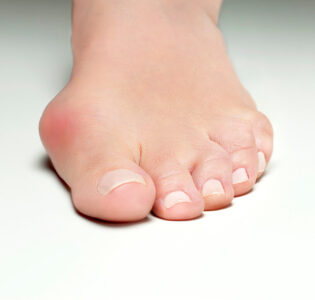 Bunions are a fairly common foot condition that we see on a regular basis, but the vast majority of cases are on the feet of older adults. However, this is not the only group who can be felled by a bunion. In some instances, bunion can develop on the foot of a teen or child who is experiencing continued foot growth and development. In today’s blog, we take a closer look at how juvenile bunions are diagnosed and treated.
Bunions are a fairly common foot condition that we see on a regular basis, but the vast majority of cases are on the feet of older adults. However, this is not the only group who can be felled by a bunion. In some instances, bunion can develop on the foot of a teen or child who is experiencing continued foot growth and development. In today’s blog, we take a closer look at how juvenile bunions are diagnosed and treated.
Understanding and Diagnosing Juvenile Bunions
As we’ve talked about on the blog in the past, a bunion is a type of foot deformity that occurs when the big toe joint shifts inward, causing a bony prominence on the outside of the toe joint. They typically develop after years of stress and wearing poor-fitting shoes, which is why they are most common among women in their fifties and sixties. However, this isn’t typically the underlying cause when a juvenile develops a bunion. Instead, this typically occurs because of a genetic predisposition. That’s not to say that the condition is unavoidable, but certain genetic factors can make it more likely that a child is susceptible to bunion formation.
Some common genetic factors may include:
- Juvenile Rheumatoid Arthritis
- Neuromuscular disorders
- Muscle tone deficits
Treating Juvenile Bunions
Adult and juvenile bunions are not typically treated in the same manner, and that’s because the child’s foot still has some growing to do. When an adult develops a bunion, conservative care is used to relieve symptoms for mild bunions, but more severe cases are corrected with surgery. For juvenile bunions, surgery typically isn’t considered because there’s a chance that the growth plate in the foot could be negatively affected. If this were to happen, a second surgery later down the road would be likely, and nobody wants that.
Instead, the goal will be to try to get the bunion to shift back towards a more natural position. This doesn’t really happen with adult feet that are done growing, but it can happen to an extent with juvenile feet. For that reason, your foot specialist will walk you through some conservative care options that will aim to provide both short-term and long-term relief. Some common treatment options include:
- Getting the child into roomier shoes
- The insertion of custom orthotics
- Regular stretching and muscle strengthening routines
- Gait improvements
- Regular progress monitoring
While all of these treatments can be helpful, one of the most important factors in treatment success likelihood is how soon the problem is identified and treated. If you notice a bony prominence on the outside of your child’s foot near the big toe joint, if they start complaining of pain in this area or you notice that they seem to be walking with a limp or an uneven gait, bring them to a foot specialist’s office. Early intervention is crucial for adjusting the path by which the big toe joint develops in juveniles, so don’t delay and just hope it goes away on its own. Be proactive and increase the likelihood that treatment is successful.